Sail of the Century (on a ship with no sails)
by steamtug on Jun.15, 2014, under Steamships
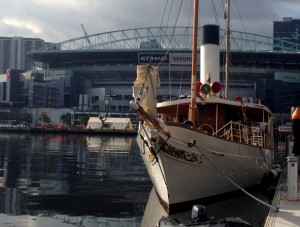 I recently sailed an antique steam yacht built in 1901 from Sydney to it’s new home in Melbourne. Steam yacht Ena is a magnificent vessel, and typical of those built in a bygone era when money was not considered to make her the best and most oppulent in Sydney.
I recently sailed an antique steam yacht built in 1901 from Sydney to it’s new home in Melbourne. Steam yacht Ena is a magnificent vessel, and typical of those built in a bygone era when money was not considered to make her the best and most oppulent in Sydney.
It’s not too far to walk from town hall station in the Sydney CBD down to Darling Harbour, but I had too many things to carry; my kit bag and my heavy box of bits ‘n bobs, making me feel like Jake Holman (Steve McQueen) in the movie Sand Pebbles, going down to the docks to meet my ship. I got to the locked gate at the quayside and saw one of the crew members for the first time. I later learned this big chap was known as ‘The bear’ and upon gaining his attention I nodded towards the lock on the gate. He picked up something from the deck, nodded back as if to say hello and disappeared leaving me standing with my heavy boxes. A great start to the adventure ahead.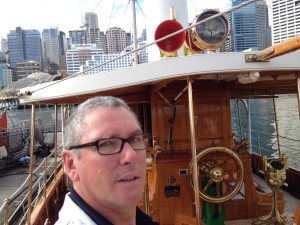
A member of the maritime museum staff finally let me in and I went down to meet the rest of the crew. They had been out for a cruise around Sydney harbour for friends of Ena, and there last chance to be on her decks in Sydney. Today we were taking the crews and members of the Sydney Heritage fleet, and steamboat association (of which I have recently joined) for their final run before we depart for Ena’s new home port of Melbourne.
There was lots to prepare, and we were still ticking off strategies listed on our risk assessment for things that could go wrong. Like how to run the condenser cooling water from the fire pump with a special hose made just for this occasion. Ena was fitted with a Yarrow water tube boiler, and fired by a factory type diesel burner that needs the ships diesel generator to be running for 3 phase power to the burner fan and fuel pump. I hate it! And when the Chief (John Davis) arrived and saw it he commented “Any steamship that relies on a diesel engine to make it go is a Failure!” and these words would be said again before arriving in Melbourne.
Ena has steamed her way around Australia and even made it to Perth for the America’s cup many years ago. So the system must work to some degree. But we couldn’t trust this burner and purchased a new “Landis” box which is the logic brain that bolts onto the burner side to control purging, flame failure, low water trips etc. The box that was fitted did work perfectly except when the low water chamber was drained for testing, the burner failed to trip. So the box already fitted did have 1 flaw so it was decided not to trust it and fit the brand new box for the voyage, keeping the other for a spare.
Next we discovered, that if you lost power, the 3 phase motor could be powered from an hydraulic system that was powered by the Mumford condenser circulating pump engine. But how do we open the solenoid valves for the fuel without power, and how do we make spark to light off? Luckily, the man that steamed her around Australia was aboard. He showed us how to run the Mumford cooling water pump and engine flat chat doing far more revs than it was designed for, then you open manual bypass valves on the burner front to light off. The chief was impressed with this new knowledge, and insisted we do the harbour cruise running from hydraulics to prove its reliability for the highly unlikely event that we would need it.
The passengers all turned up, and the secretary of the steamboat association arrived and presented the Turner family with the SBAA flag to fly from our mast on the voyage. I recognised him from his name badge and commented that I want one too! He turned to me and said, well firstly you need to buy a steam boat then join our association to get a flag. I protested that I had already met those conditions, and introduced myself. He got a surprise to meet me, as we had been sending emails back and forward over the past few months as I try to find more history on my own boat Edelweiss which I recently purchased.
That’s not how you run an engineroom!
While manning the engines during Ena’s final cruise around Sydney Harbour flanked by Boomerang and the elegant Lady Hopetoun, a chap with a pony tail came down to confront me on how I was running the engineroom. “You can’t run that cooling water pump like that, it’s going way too fast” not knowing who he was I told him that’s how I like to do it. “But that’s not how we ran it” but this is how I run it, and it’s my ship now. Who are you anyway? He was the old manager that looked after the ship for the wealthy owner who never came down to see what he was doing with the money. He just walked away disgruntled that we were all cowboys who didn’t know how to run a steamship. I let him leave with that impression failing to tell him we were running the hydraulic system, as I didn’t like his attitude.
It was a great cruise out on the world’s most picturesque harbour with the news helicopter circling overhead, and a flotilla of historic vessels following us, we felt very special as the ABC news crew took footage and interviews during and after the voyage.
Time past all too quickly and the cruise was over too soon. Beers on the aft deck encouraged the group to hang around. Not that they needed encouragement, as they were all steam ship enthusiasts, a hard crowd to find in Victoria, so I mingled and chatted trying to not let the captain notice the 2nd engineer was drinking the beer for the guests. It was amazing to meet so many people who were names I had heard, or people I had emailed but never met face to face, and I savoured the moment knowing that we would soon be on the high seas at sun up in the morning.
All squared away, cruises completed, official engagements done, everything ship shape, the crew all headed up to the Pyrmont Bridge hotel for our ‘last supper’. We convinced the bar maid that we were important enough to change the TV in the bar away from the rugby and over to the ABC news in time to see the report on our day out on the harbour. It was great to see the interviews, and footage of us passing under the coat hanger from the helicopter with all our escorting flotilla surrounding us like a queen Bee. We were chuffed as we sipped our beers and shouted to the pretty bar maid that it was us on the tele!
Click here for ABC news article
Crikey! The fire’s just gone out!!
We dragged ourselves from our warm little bunks at 4am the next morning and excitedly flashed up the boiler and began preparing for sea. It was hard to sleep with the anticipated excitement and tense atmosphere of the adventure ahead. And as the sun painted red streaks in the morning sky, we quietly slipped from our berth and down the harbour for the last time, without the fanfare, TV news helicopters, girls pointing at the handsome sailors on board. Just us sneaking away with the light breeze and chop on our bow. Sydney slipped under our stern and we were soon heading between the rocky points of North and South head.
With our nose out facing the open ocean, and the opening to Sydney heads now behind us, we turned downwind, southward to finally begin the true purpose of our quest. But as we turned the wave pattern which had changed from a harbour chop, turned into a rolling swell; still around 2 metres from the day before. The first decent roller caught under our bow, lifting our little ship up and over, rolling the water in the boiler, to empty the low water cut out chamber causing it to shutdown the burner. Of course water instantly returned when the shop rolled back, but the fire didn’t as the burner logic didn’t care. It had seen a problem and took immediate action to keep us all safe from an exploding boiler, shutting down the fire and turning a danger that didn’t really exist, into a real danger if we didn’t work out how to get the fire back.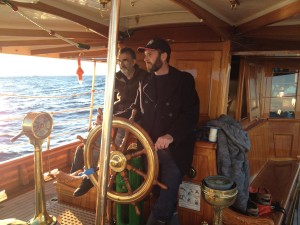
Water tube boilers like this, are quite different to the old scotch boilers I am used to. Wattle’s scotch boiler for example contained 20 tons of water and could steam happily for 10 minutes after the fires had gone out, without even seeing the steam pressure drop too much. (She also had 2 fires instead of 1, and a totally manual system with no wires, all run from the steam in the boiler). This yarrow water tube boiler contains only a tea pot full of water (seems like…) and it always amazes me how fast the pressure gauge jumps when a big fire is pushed up her back passage.
So Tommy’s announcement that the fire had thought it much too dangerous to keep burning came as a bit of a surprise after we had played with burner control boxes and thought we had all contingencies covered, yet 5 minutes in the open ocean we faced out first failure. Remember that “Landis” control box that we thought was defective because the low water cut out didn’t work? Could it be that this was done on purpose? Recovery option 1 was to pull off the perfect box and refit the defective one. This was done in record time but the burner failed to respond at all this time. Oh crap! The main engine had already been slowed to half speed was reduced further to slow so we could at least keep the ship pointed in the right direction, as opposed to broaching the swell beam on, or worse still heading back towards the rocks which luckily were still far away.
“Get the hydraulic system going!” called the Chief is desperation. Belts were chucked on and the little Mumford pump stepped up to the challenge and pushed with all her might. The generator was still on, so 240v power was used to drive the sparker and the fuel valves manually opened and away went the fire! We are saved!!! The little Mumford continued to support us for the next 30 hours, all the way to Eden.
Sitting in the engine room at watch change one night, Tom and I were looking at the punishment the Mumford was taking. “It’s like cruelty to dumb animals, isn’t it?” as the little engine, doing a gazillion revs per minute lapped up the challenge and loved every minute!
Hydraulic Lock
Tommy relieved me at midnight for the middle watch and after I shared a cuppa with Russ the rat in the galley I snuggled down in my bunk, drifting off to sleep. Asleep or not, your ear always pricks up when the noise of the engines constant speed in the compartment on the other side of the bulkhead changes. The thump of the loose valve guide on the LP valve rod slowed, and then I heard Tommy’s voice calling for hands to the engineroom. I beat the Chief there to find the fan on the boiler burner slowing down. Tom 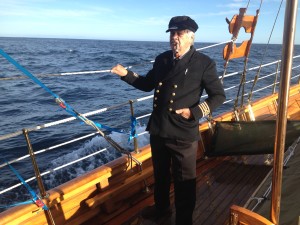 had already established it was the hydraulics, and another hiccup pointed to a lack of fluid in the system.
had already established it was the hydraulics, and another hiccup pointed to a lack of fluid in the system.
It was leaking on the pressure gauge fitting and over many hours had lost enough for the pump to lose suction leaving the boiler fire, just hanging in. We added grabbed the nearby drum of lube oil that was nearby and although not the correct grade of oil, did the trick after pumping some into the tank and the system burst back into life. Disaster averted, I headed up the companionway yelling back to Tom that I couldn’t leave him for longer than 1.5 hours without breaking something! He yelled back an obscenity and laughed as I went back to bed.
Sea sickness
The chief engineer (John Davis) and Mate (Old Tom) slept in the forward “Ladies Saloon” cabin. The ship’s master (Hamish Turner) slept in the saloon on the aft deck. The rest of us shared the scents of old socks and stale flatulence in the “Gentleman’s saloon” cabin down aft. Here we had myself 2nd Engineer (Mark Dye), 3rd Engineer (Tom Lord), the boatswain (Darren Mann), and the poor 4th Engineer (Darren Downey) who was suffering the worst case of sea sickness I had ever seen. He had managed only to lift his head from his bunk to dash up the companionway to feed all the fish between Sydney and Eden. Worried about his welfare, big Darren suggested we take a quells, coat it in Vaseline and insert it up his back passage. “Why would you do that?” I asked. “Because everything appears to be going in that direction, might be the only way to get it into his stomach!”
Our “Peggy” Russell the bilge rat, slept in the galley so he could keep a check on what supplies were being pilfered by the crew after he discovered old Tom coming out with an inch thick slice of his beloved plastic cheese. He was complaining about who was taking what from the galley (half tongue in cheek) and I decided to come clean and confess that if he counted the minties from the lolly box, and found 1 missing, that it was me who took it. Darren found a big stash of chocolate biscuits during a late night assault and appeared at the engineroom companionway passing down chocolate royals for the chief and me, followed up with a tim tam! Whoo!! We were living the high life while the rat was asleep.
Because Ena is so fine in beam, and light in the water, I think she would roll on wet grass. So the seas on Australia’s South, East coast easily turned our posh Sydney Harbour socialite, into a “chunder bucket”. I have never been sick before, but even managed at least 1 spit, and lots of time feeling nauseous and thinking “Do I really have to put some more oil on that LP valve rod bearing? It’s already clunking, so oil isn’t going to fix it. We all felt sorry for little Darren who usually works on a river boat. Tom the 3rd also had to lie down sometimes, and when I heard the master Hamish also had a spit, made me feel less of a failure.
I was on watch when we arrived in Eden and missed the view coming into the harbour. There was lots of whistling to say “HI!” to Eden as we rounded the harbour entrance and drew attention to the world’s most beautiful yacht. After making fast and “finished with engines” was rung down, I was surprised to come up from below and see so many people waiting on the pier. Spectators, fisherman and newspaper reporters; it was obvious our publicity machine had been working ahead of us. But all the fuss didn’t delay “Bear” from our accompanying vessel “Blizzard” headed for the showers, and the rat headed up the hill to the pub. The rest of us greeted the visitors, giving tours aboard before enjoyed having a toilet ashore that didn’t move while you were sitting on it, and flushed without a bucket, then all headed up the hill to the pub for a meal that hadn’t been cooked by a grumpy rat, while Tom the third helped Andy, the electrician from Blizzard refit the Landis box and disable the low water cut out so we could get the burner working normally again.
The sun came up just in time to watch us steam gracefully out of Boyd’s Bay and their famous lighthouse, and I enjoyed the view with 2 hours before I was due on for the forenoon watch (8 – 12). The mate took another fix on the charts and stepped his dividers out announcing to anyone in ear shot that we had 70 hours to go for our next leg around Wilsons Promontory, the world famous ‘rip’ and up the great ship channel into Melbourne.
The boys had done a great job on the boiler burner logic, and we were able to run back on electric power and stop punishing the poor little Mumford pump, even though she never complained, and her bearings never even got warm all the time she was flogged. Instead of losing the fire on each wave, which sounded loud bells to panic the passengers, we just had a very discreet soft beep from the boiler control box that only the engineer know what it was, blended in with other engineroom squeaks. When they became more frequent, you knew it was time to speed up the weir boiler feed pump. A great system, that should never have been fiddled with!
Wilsons Promontory
We had run out of fresh water in the galley and only had the belly tank under the boiler left. As it was difficult to transfer from this tank, we decided to just get some water from Blizzard; after all that’s why she was on this trip and we hadn’t needed her help yet. So we made a plan to heave to behind skull rock on the bottom tip of the prom, right on the most southerly point of Australia. (Tasmania is a different country anyway…)
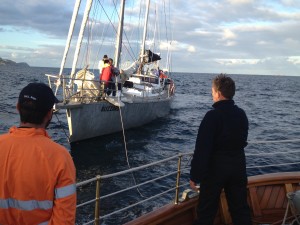 While the engines were stopped, the chief double checked all the bearings for temperature and topped up with oil the cups which are hard to reach as she thrashed about at a steady 108 rpm to propel us at 8 knots. We on deck cast a heaving line towards Blizzard and pulled in a 2 litre plastic container of fresh water. Once aboard, our Captain Hamish cheekily yelled “We got our water now, so nick off!”. Andy the electrician standing on the helm of Blizzard was surprised by this, and cracked into a big smile to reply “You don’t know what we did to that water… ha ha ha, now you’ve got it and not getting any more!” A large Albatross that had been looping back and forward across our stern for many miles to follow us, bobbed up and down on the water and laughed at the exchange, while wondering when we were getting back underway.
While the engines were stopped, the chief double checked all the bearings for temperature and topped up with oil the cups which are hard to reach as she thrashed about at a steady 108 rpm to propel us at 8 knots. We on deck cast a heaving line towards Blizzard and pulled in a 2 litre plastic container of fresh water. Once aboard, our Captain Hamish cheekily yelled “We got our water now, so nick off!”. Andy the electrician standing on the helm of Blizzard was surprised by this, and cracked into a big smile to reply “You don’t know what we did to that water… ha ha ha, now you’ve got it and not getting any more!” A large Albatross that had been looping back and forward across our stern for many miles to follow us, bobbed up and down on the water and laughed at the exchange, while wondering when we were getting back underway.
Pushing onwards through the rock islands of the Wilsons Promontory point that make this place so special, and the wind right on our nose, we discovered what we always suspected, in that Ena is a “wet” boat that prefers to go through the waves, rather than over them. This can be confirmed by big Darren who while sitting at the helm 10 metres back from the bow, saw her bury her nose into a big wave and flick it over her decks drowning him in a big sea of green cold water! Did I mention she has an open platform out in the weather on which to stand and steer? Very cold in the wee hours while rounding the waters of the deep south.
Rounding Cape Liptrap at sunset, Cape Patterson next to Phillip Island, Cape Schanck that I have rounded a few times in my own boat Adaqua, then closing in on Port Philip Heads. The engineroom got tired of changing speed as we fought with Blizzard about our arrival time at the heads. “Speed up or we will miss the tide.” No clear plan as to what time we are going through. “Slow down, the newspaper photographers might be there to see us come through the heads. Ok, speed up again it’s too dark anyway”. Then slow down again there is a ship coming that we must share the channel with. Us engineers were growing impatient with the multiple decisions on what speed to do. Don’t they know how difficult it is to get everything settled back down and running efficiently again after a speed change? Boiler fuel pressure, feed pump speed, circ pump speed to get the condenser vacuum right without over cooling the condensate, then they would change again! I called up the voice pipe, this is not a diesel engine like Blizzard has. Show some respect for this old lady!
We followed the ship into Port Philip heads and branched off around Queenscliff when the ship turned right to follow the deeper South channel. We on the other hand took the shallower West Channel, then straight up the bay to Williamstown, and up the river to docklands. Even the dolphins came out to play on our bow and appreciate the new toy we had brought such a long way, just for them.
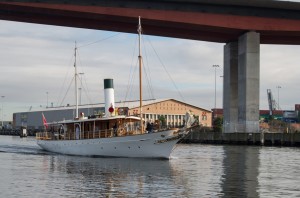
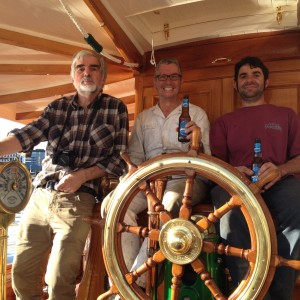
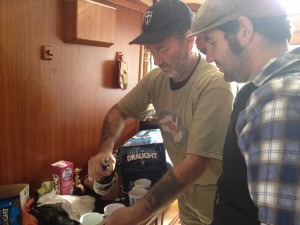 I emerged from the engineroom after the captain had run “finished with engines” to see we had the best berth in docklands, right under the footy stadium. Many people milled around on the pier to see we had arrived, and all sorts of people came out of the wood work. Even Ned Dawson, the former owner of Lyttleton II came down the gangway with a box of beer for the boys. A huge party followed as the realisation that we had achieved our main objective sunk in, and Darren uncorked a special bottle of spiced rum for us all to sip and savour the moment.
I emerged from the engineroom after the captain had run “finished with engines” to see we had the best berth in docklands, right under the footy stadium. Many people milled around on the pier to see we had arrived, and all sorts of people came out of the wood work. Even Ned Dawson, the former owner of Lyttleton II came down the gangway with a box of beer for the boys. A huge party followed as the realisation that we had achieved our main objective sunk in, and Darren uncorked a special bottle of spiced rum for us all to sip and savour the moment.
Warwick Turner arrived with a big suitcase filled with copies of the “Ena” book, giving all the crew a memorial copy to celebrate the occasion. We, the crew, all laid our books out on the quayside and lined up to sign each other’s copy. A great moment captured in so many ways. We were glad the trip was over as we sipped our beers and really didn’t want to go home and all we could talk about, was when we were going out next! Welcome to Melbourne Ena! Long live the Queen of the seas! Mark Dye 2nd Engineer
The crew who survived the voyage of Ena from Sydney to Melbourne, June 2014
from left, Russ (bilge rat) Anderson –Peggy, Mark Dye -2nd engineer, Darren Downey 4th engineer, Hamish Turner –Master, Tom Hughes (Old Tom) –mate, Thomas Lord -3rd engineer, John Davis –Chief engineer, Darren Mann -Boatswain
Click here for video “Steam Yacht Ena sails Sydney to Melbourne”
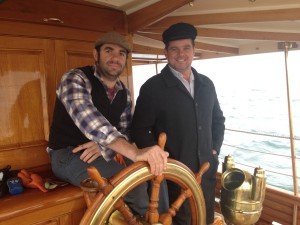
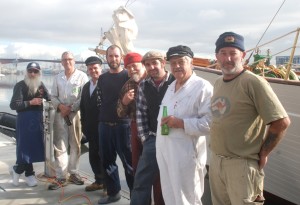
August 30th, 2017 on 10:23 pm
Can I just say what a relief to discover somebody that actually knows what they’re talking about on the internet.
You definitely realize how to bring a problem to light and make it important.
A lot more people really need to check this out and understand this side of your
story. I can’t believe you aren’t more popular since you certainly have the gift.